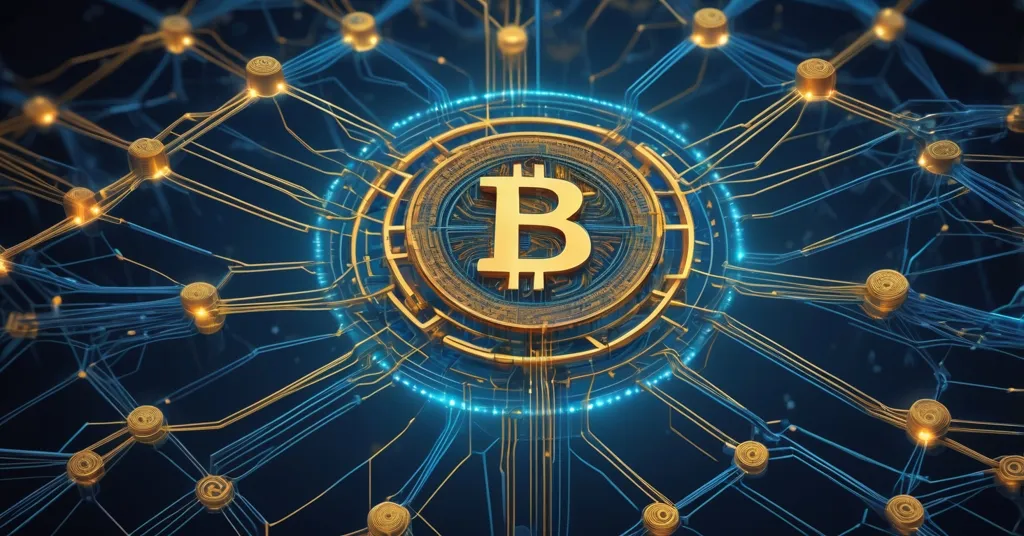OpenAI’s Open-Weight AI Models: A Decentralized Tech Revolution for Crypto?

OpenAI Drops Open-Weight Models: A Game-Changer for AI and a Wink to Decentralized Tech
OpenAI has just shaken up the tech world with the release of two open-weight AI models, gpt-oss-120b and gpt-oss-20b, marking their first venture into this space since 2019. This bold move toward accessibility and customization in artificial intelligence carries echoes of the decentralized ethos we live and breathe in the Bitcoin and blockchain communities, hinting at a future where user control and innovation could intersect in powerful ways.
- Groundbreaking Release: gpt-oss-120b and gpt-oss-20b are freely downloadable and customizable under an Apache 2.0 license.
- Wide Accessibility: Available on GitHub and Hugging Face, runnable on everything from laptops to cloud servers with support from Nvidia, AMD, and more.
- Decentralized Vibes: The open-access approach mirrors Bitcoin’s rejection of gatekeepers, with potential to inspire blockchain-AI synergies.
Unpacking Open-Weight Models: What’s the Big Deal?
For those new to the AI game, let’s break this down. Open-weight models mean the core building blocks of these large language models (LLMs)—think of them as the numerical DNA that dictates how the AI thinks and responds—are publicly available. Unlike fully open-source projects where every piece of the puzzle, including training code and datasets, is shared, OpenAI is only handing over the weights. Still, under the Apache 2.0 license, anyone can download, modify, and deploy these models without shelling out for licensing fees or being tethered to proprietary APIs. They’re hosted on platforms like GitHub and Hugging Face, and tools like LM Studio or Ollama make it dead simple to run them locally on your own hardware or scale up in the cloud. For a deeper understanding of the organization behind this, check out the OpenAI overview on Wikipedia.
What sets gpt-oss-120b and gpt-oss-20b apart is their flexibility. These text-only models can operate on a range of hardware, from a beefy consumer laptop to high-end servers, supported by chips from industry giants like Nvidia, AMD, Cerebras, and Groq. The larger gpt-oss-120b is a powerhouse, while the smaller gpt-oss-20b can even run on a phone—a feat that’s frankly nuts. Their capabilities include chain-of-thought processing (solving problems step by step, like a human mulling over a tough question), tool usage (interacting with external software or data), and multi-step reasoning (handling complex, layered tasks). OpenAI’s own researchers, like Chris Koch, claim gpt-oss-120b matches or beats proprietary models like o3 and o4-mini in benchmark tests, a point echoed by Nvidia CEO Jensen Huang who praised the innovation behind this rollout. For more on the release details, see OpenAI’s announcement of these models.
“OpenAI showed the world what could be built on Nvidia AI — and now they’re advancing innovation in open-source software.” — Jensen Huang, Nvidia CEO
OpenAI President Greg Brockman also highlighted the broader impact, pointing to the growth of an ecosystem they’re thrilled to shape.
“It’s been exciting to see an ecosystem develop, and we are excited to contribute to that and really push the frontier and then see what happens from there.” — Greg Brockman, OpenAI President
Even CEO Sam Altman couldn’t hold back his excitement on Twitter, marveling at the tech’s ability to run on everyday devices with performance rivaling top-tier models.
Safety First: Guardrails in a Wild West
Before we get too starry-eyed, let’s talk about the darker side—because if the crypto world has taught us anything, it’s that unchecked power can turn into a dumpster fire fast. OpenAI knows that releasing potent AI into the wild comes with risks. They’ve taken steps to filter out sensitive content during pre-training—think data related to chemical, biological, radiological, or nuclear threats that could be abused. They’ve also stress-tested these models against malicious fine-tuning, ensuring they don’t cross into dangerous territory as defined by their Preparedness Framework. Safety researcher Eric Wallace confirmed that even under adversarial conditions, the models didn’t hit “high capability” harm levels, and external audits were brought in to double-check their work. Dive into the specifics of these precautions in OpenAI’s safety measures documentation.
Sound familiar? It’s not unlike the crypto space, where open-source code gets audited to spot vulnerabilities, yet proprietary elements—like certain wallet tech—stay locked down for security. OpenAI’s playing a similar balancing act here, but let’s call a spade a spade: keeping training data and code under wraps isn’t full transparency. It’s a half-measure, and while it might mitigate some risks, it also means we’re trusting their word on what’s been scrubbed or secured. Much like Bitcoin’s early days faced scrutiny over illicit use, AI’s open-weight trend could invite regulatory heat if safety falters—just look at how fast governments clamped down after Silk Road. Will this spark overreach akin to crypto’s regulatory battles? It’s a question worth asking.
Decentralization Parallels: Bitcoin’s Spirit in AI?
Now, let’s zoom in on why this matters to us in the Bitcoin and blockchain crowd. OpenAI’s shift isn’t directly tied to crypto, but the parallels are hard to ignore. By making these models downloadable and customizable, they’re slashing reliance on centralized gatekeepers—sound like a certain peer-to-peer digital currency we know? Bitcoin disrupted finance by cutting out banks, and here OpenAI is (partly) cutting out the middlemen of AI, letting developers, hobbyists, and even your average Bitcoin enthusiast tinker with cutting-edge tech. It’s a nod to user sovereignty, a principle at the heart of decentralization. For a broader discussion on how these concepts align, explore this explanation of centralized vs. decentralized AI.
Even the hardware angle resonates with crypto’s roots. Support from diverse providers like Nvidia and Groq means compute power isn’t locked to one monolithic player, much like how Bitcoin mining evolved from niche rigs to widespread, accessible hardware over time. This push toward distributed access aligns with effective accelerationism (e/acc), the idea of speeding up tech progress through open, decentralized systems—a stance we champion. OpenAI might not be chanting “HODL,” but their ethos here vibes with the freedom and disruption we’ve fought for since Bitcoin’s genesis block.
Commercial Moves and Competitive Heat
On the business front, OpenAI isn’t going solo. They’ve partnered with big dogs like Amazon Web Services (AWS), Microsoft, and Baseten to host these models. AWS, dipping its toes into OpenAI waters for the first time via Bedrock and Sagemaker, is pitching itself as a neutral marketplace for AI tools. Amazon CEO Andy Jassy has emphasized offering a buffet of options, not just pushing in-house tech. Meanwhile, OpenAI’s stepping into a ring already packed with heavyweights like Meta (with its Llama series), Microsoft-backed Mistral AI, and even DeepSeek out of China, all peddling open-weight or open-source models. This isn’t just innovation—it’s a survival play in a cutthroat market. For a comparison with competitors, check out this Reddit thread on open-weight model performance.
But let’s play devil’s advocate. Is this truly about democratizing AI, or a slick PR move to keep pace with competitors? Whispers in tech circles, like on Reddit’s r/LocalLLaMA, suggest OpenAI might’ve rushed this out to counter obscure players like “Kimi.” And with Meta’s Mark Zuckerberg reportedly rethinking open-source due to safety fears, the trend toward openness isn’t guaranteed. Much like crypto projects that promise decentralization but cling to control, OpenAI’s “open” label comes with fine print. They’re still gatekeeping the full recipe, and that’s a red flag for anyone who’s been burned by half-baked promises in this space. See more community reactions in this discussion on decentralized tech and gpt-oss models.
Future Synergies: Blockchain and AI Collision Course
So, where could this lead for decentralized tech? Picture this: a Bitcoin maximalist using a tweaked gpt-oss model to analyze market sentiment, powered by a blockchain app that verifies the computation on-chain. Or imagine decentralized AI marketplaces, where access to models like these is tokenized—think digital assets on Ethereum or Bitcoin sidechains granting usage rights, cutting out corporate middlemen. Projects like Bittensor, which incentivizes AI compute power with crypto tokens, or Fetch.ai, blending AI with blockchain for autonomous systems, are already laying groundwork. OpenAI’s release could supercharge such ideas, especially if privacy-focused AI leverages crypto protocols like zero-knowledge proofs to keep data secure. For more on potential applications, read up on blockchain integration with open-weight AI models.
That’s the optimistic take, and I’m all for it—disruption over stagnation any day. But let’s not ignore the pitfalls. If misused, AI could amplify crypto scams—think AI-generated fake news tanking Bitcoin’s price overnight or bots pumping rug-pull tokens. We’ve seen how fast bad actors exploit tech, and this is no different. Plus, if governments get spooked by AI risks, expect crackdowns that could spill over into crypto regulation, mirroring past overreactions to Bitcoin’s darker uses. Balancing innovation with accountability? That’s the million-BTC question. For insights into broader implications, take a look at how these models impact blockchain tech.
Could Ethereum’s smart contracts play a bigger role here than Bitcoin? Maybe—programmable blockchains are tailor-made for automating AI access or payments. But as Bitcoin maximalists, let’s argue the purist line: true decentralization starts with Bitcoin’s unshakeable foundation. Altcoins and other protocols like Ethereum fill niches, no doubt, but Bitcoin’s ethos of raw, unstoppable freedom remains the north star. OpenAI’s move, imperfect as it is, feels like a step toward that spirit. For a perspective on combining these technologies, see Bitcoin and AI integration possibilities.
Key Takeaways and Burning Questions
- What are gpt-oss-120b and gpt-oss-20b, and why should crypto folks care?
These are OpenAI’s new open-weight AI models, free to download and tweak under an Apache 2.0 license. They matter to the crypto crowd because their open-access nature echoes Bitcoin’s push against centralized control, hinting at user-driven innovation. - How is OpenAI handling safety risks with these powerful tools?
They’ve scrubbed sensitive data, tested against malicious use, and brought in external audits to limit harm. Still, withholding full training details raises transparency concerns, much like proprietary crypto tech does. - Does this align with Bitcoin’s decentralization principles?
Hell yes—at least in spirit. Letting users control and modify AI without gatekeepers mirrors Bitcoin’s rejection of financial intermediaries, though OpenAI’s partial openness keeps it from a full endorsement. - What’s the potential for blockchain-AI mashups?
Huge, if done right. Think tokenized AI access on blockchain networks, verifiable computations via smart contracts, or privacy-first AI with crypto tech. Projects like Bittensor show it’s already in motion. - What’s the catch with OpenAI’s so-called ‘open’ stance?
It’s not the full monty—training code and datasets are still locked away. True decentralization, whether in AI or crypto, rarely comes without strings, and this is no exception. - Are there risks for the crypto space from this AI push?
Definitely. Misused AI could fuel scams or market manipulation, like fake news crashing Bitcoin prices. Plus, regulatory blowback on AI might bleed into crypto, echoing past crackdowns we’ve endured.
Stepping back, OpenAI’s release of gpt-oss-120b and gpt-oss-20b is a seismic shift in AI, one that resonates deeply with the crypto community’s hunger for freedom and disruption. It’s not a flawless victory—half-measures on transparency and looming risks keep us on our toes—but it’s a damn good start. As we watch this unfold, the fusion of AI and blockchain feels tantalizingly close. Are we on the cusp of a new decentralized frontier, or just falling for another shiny distraction? The crypto world’s been burned before, so let’s keep our eyes wide open. History, and Bitcoin’s relentless rise, tells us betting on disruption is usually the smarter move.



